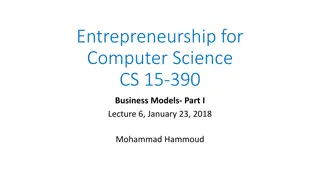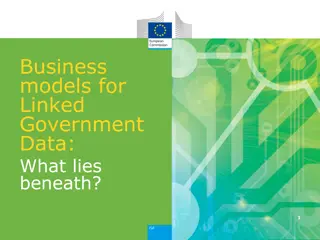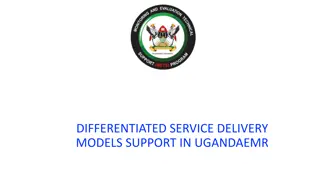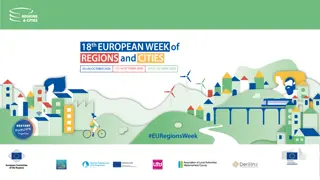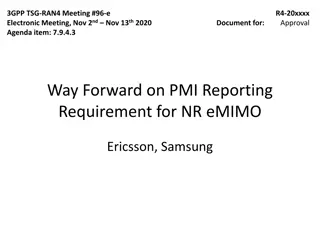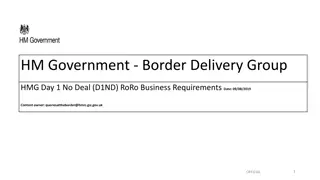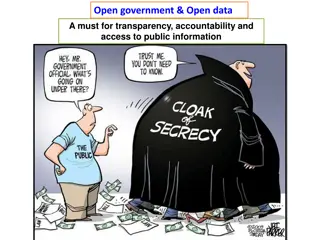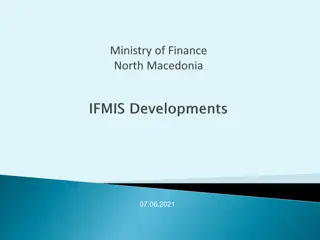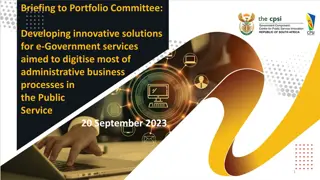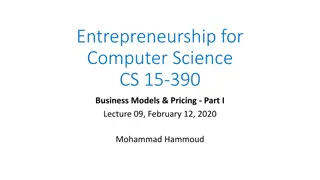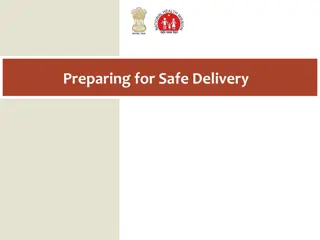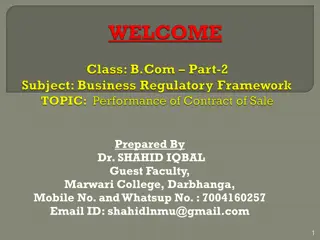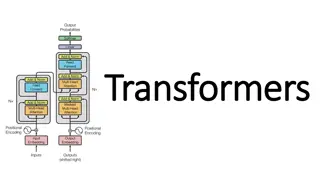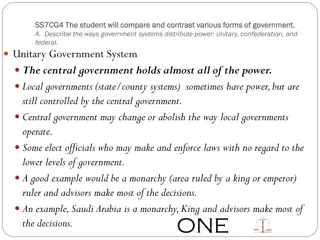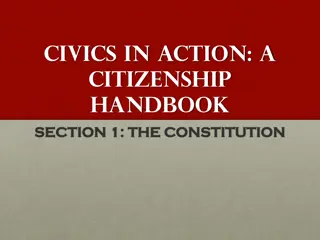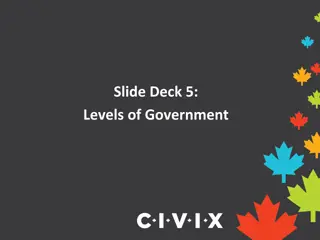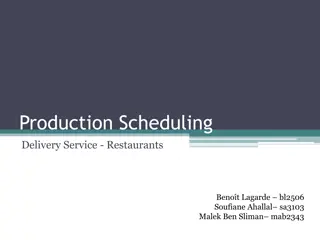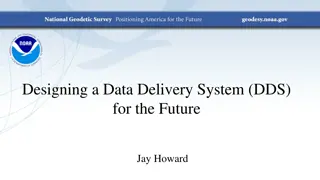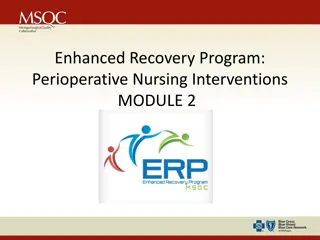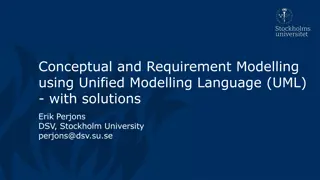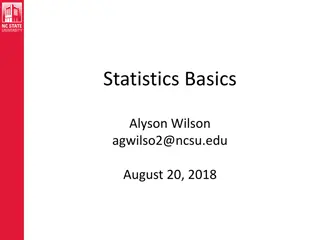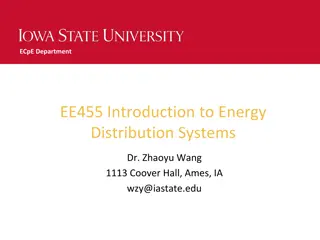Understanding E-Government Business Models for Enhanced Service Delivery
E-Government business models play a crucial role in enhancing service delivery in the public sector by simplifying complex operations and strategically adapting to changing market conditions. This concept supports organizations in analyzing success factors, developing new ideas, and creating superior service offerings. The adoption of business models in e-government endeavors worldwide reflects the importance of continuous adaptation and value creation for society.
Download Presentation

Please find below an Image/Link to download the presentation.
The content on the website is provided AS IS for your information and personal use only. It may not be sold, licensed, or shared on other websites without obtaining consent from the author. Download presentation by click this link. If you encounter any issues during the download, it is possible that the publisher has removed the file from their server.
E N D
Presentation Transcript
E-Government Business Models Chapter 4 1
E-Government Business Models the term business model is closely related with creating competitive advantage. Digitalization, globalization, deregulations( ), economic integration have led to more dynamic, more competitive, and more complex markets. This situation forces companies to constantly adapt to the steadily( ) changing market conditions in a quick and efficient manner. 2
E-Government Business Models business models is an important leadership and management tool by simplifying the complexity of reality. Moreover, the process of designing and developing business models supports the generation of new business ideas as well as the assessment of existing strategies, structures, and business activities. Thus, the business model concept supports organizations in systematically analyzing their success factors and adapting their business activities in a target-oriented way 3
E-Government Business Models Transferred to the public sector, a business model represents the service systems of a public sector organization and illustrates in a simplified, aggregate form which resources are used and how these are transformed into the service offering of the public sector organization. a business model contains information about the strategy of the public sector organization, the production factors, and the functions the actors involved have. Thus, the business model approach can be considered as a public management instrument that supports the systematic creation of better, superior service offerings and provides public services for society with higher value for the public. 4
E-Government Business Models Moreover, business models are considered especially suitable for e-government endeavors( ) since they assist and encourage the continuous adaption to new circumstances. These are key reason why the business model concept is regarded as appealing and useful in the public sector and why governments worldwide are increasingly applying business models to enhance their e-government-related service delivery. 5
4.1 Business Model Concept In terms of e-government, there is general agreement of the nations that establish and promote( ) e-government, to set up electronic systems for handling administration and democracy processes in the context of governmental activities by means of information and communication technologies to support public duties efficiently and effectively. this orientation on the supranational level provides a strategic and operative direction for setting up an e- government business model. From an integrative perspective, several interdependent business model levels can be distinguished: supranational, national, regional, and local. 6
4.1 Business Model Concept the supranational level reflects the orientation of e-government in an international or global context. An important factor for the design, functionality, and management of the national, regional, and local levels is the nation s political imprint( ) concerning its centralized or decentralized character. While countries with a decentralized character rather possess powerful public authorities on a regional and local level, countries showing a centralized character focus on expertise and competencies at a central or supreme( ) authority level. public business models from politically centralized and decentralized nations tend to show differences with regards to service orientation and responsibility. 7
4.1 Business Model Concept Business models for the local level, which primarily aim at providing the community with e-government services, show a stronger user orientation than the levels above and provide the main platform interfaces for user access. For this reason, the local level should demonstrate( ) the highest usage intensity( ). This relationship could be observed in a recent e-government user survey( ). The study showed that local e-government portals are the main Internet interface between the government and the citizens. Nearly half of the participants (43%) demonstrate high and very high usage of city portals, while these figures are 15% and 8% for regional and national portals respectively. 8
4.1 Business Model Concept The three main directions for business model are the technology-oriented, the organization-oriented, and the strategy-oriented approach. The technology-oriented business model approach is heavily influenced by the concepts of business modeling and electronic business. Many electronic business concepts are explained by this approach. 10
4.1 Business Model Concept Creating superior organizational design is at the heart of organization-oriented approaches. Here, size and composition of units, responsibilities, roles, organizational culture, organizational learning, etc. within an organization are defined to create a more efficient and more effective organization and thus a competitive advantage. The third direction is the strategy-oriented approach, which creates a close connection between an organization s business model and its strategy, taking into account the internal and external view on the organization, as well as its core assets and core competencies. 11
4.1 Business Model Concept Although these three main directions show clear differences concerning their orientations, all approaches share the assumption that business model processes are an important aspect. For this reason, also processes are a fundamental part of business models. Definition of Public Business Model: A public business model is a simplified and aggregated representation of the relevant services, processes, and activities of a public sector organization that describes how information, products, and services that create additional value for society are developed and managed, while also considering strategic and processual as well as user and public demand components to support sustainable public value creation for society and the public service remit( ). 12
4.1 Business Model Concept A business model for a start-up of a local e-government platform, being built on initial data and assumptions and aiming to get the e-services running, as well as quickly acquiring a decent user base, is significantly different from a business model that is. the primary objective of the business model is always connected to developing, implementing, and maintaining a sustainable, successful organizational advantage. Furthermore, a business model should always integrate the relevant internal and external aspects and present an aggregated conceptual framework of the underlying components. 13
4.1 Business Model Concept This framework consists of partial models that provide the basic input for the integrated public business model, which is made up of three component layers: the public strategic component, the customer/user and public demand component, as well as the public value creation component. These three components consolidate( ) the strategy, user, public demand, and public value creation perspective to finally lead to an overarching( ) business model that is set up on the necessary level of detail, while providing the advantage of reduced complexity required for effective and efficient management. 14
4.1 Business Model Concept The following is partial models in the integrated public business model see figure 32: 1) In the strategy model, the e-government leader determines the long-term targets of the e-government system. Thus, this partial model contains the public mission, the strategic positions and development paths, as well as the public value proposition of the e-government system. 2) The resources model serves the integration of the public assets and core assets as well as the public competencies and core competencies that are relevant for public value creation. Therefore, the resources model represents a summary of all relevant value-creating input factors of the business model. 15
4.1 Business Model Concept 3) The network model provides an overview of vital( ) public business model partners that have a significant impact on the public value creation process as well as of important connections between the different public business models. This model can be regarded as a management instrument to control and manage different network partners, processes, and services. 4) The customer/user model identifies the customers/users that are relevant for the public business model. Since it is not reasonable to manage customers/users on an individual basis, specific target groups need to be determined. 17
4.1 Business Model Concept 5) The public demand offer model is concerned with the external demand analysis, which primarily assesses public stakeholder needs, demands, and behaviors. Here, further relevant external aspects like legal or political changes as well as future developments of information and communication technology are important since these may influence public online service provision. 18
4.1 Business Model Concept 6) The tax/fee model determines the public sectors organization s cash inflows( ), such as fee streams, service charge streams, and tax streams. These cash inflows can be classified into direct and indirect as well as transaction-dependent or independent forms. Whereas direct streams are generated through the service provided and the related fee itself, indirect streams are generated through additional activities, such as sponsorship or marketing of advertising space on the portal. Cash streams that are directly linked to a specific transaction are called transaction-dependent, while transaction-independent streams are already generated through the service provision itself and are thus independent from the actual usage of the service. 19
4.1 Business Model Concept 7) The public service provision model defines the key parameters for the customer/user-oriented service provision business model by determining the services that are offered to the customer/user target groups and its related processes. 8) The public procurement model describes the structure and sourcing of the input factors as well as the related analysis, monitoring, and controlling activities. For this purpose, the public procurement model contains the goals and measures for systematically procuring( ) the relevant input factors for the service offering as well as managing and optimizing the related processes. 20
4.1 Business Model Concept 9) The budget model combines the budget, cost structure, and cash flow perspective into an integrated partial business model, which reflects the monetary impact of the other partial models. Thus, it presents the cost, revenue, and cash flow streams of the public sector organization. 21
4.2 ICTI E-Government Business Model Approach The relevant public business models in an e-government context can therefore be classified into four basic stand-alone business models: Information, Communication, Transaction, and Integration (ICTI). As laid out( ) before, this ICTI E-Government Business Model Approach is based on an abstraction of e-government service provision characteristics. Against the background that all four e-government business models can be regarded( ) as independent, separate public business models, which could be applied and operated individually, these fulfill( ) the prerequisites of being stand-alone e-government models. Nevertheless, most e-government portals today are hybrid business models that apply a combination of the four basic stand-alone models. 22
4.2 ICTI E-Government Business Model Approach The development of public business models paralleled the advancement of modern information and communication technologies. For this reason, the first one was the Information Business Model, presenting static information to the users. With increasing data transmission capacities and more sophisticated( ) software and programming languages, the technological environment allowed the design of new business models, such as the Communication or Transaction Business Model. 24
4.2 ICTI E-Government Business Model Approach The Information Business Model builds upon the strategy to provide users with information in a simple, convenient, and appealing( ) way. Thus, key processes of this business model are collecting, selecting, systemizing, structuring, compiling, and packaging information as well as presenting and providing the respective content on an online platform. 25
4.2 ICTI E-Government Business Model Approach The Communication Business Model follows the approach to provide the users with a comfortable online communication platform. For this reason, setting-up, maintaining, and developing of online communication exchange possibilities, which support and foster( ) interaction between public administration and its stakeholders, are key activities. 26
4.2 ICTI E-Government Business Model Approach The Transaction Business Model targets at the initiation, handling, and processing of administrative procedures through the e-government platform. The core aim of this business model is to complement or partially or fully substitute existing offline government services. Therefore, automatization and data processing, service bundling( ), and service development are important core competencies that are required for realizing the e-government platform. 27
4.2 ICTI E-Government Business Model Approach The Integration Business Model aims at integrating public stakeholders directly into the value chain of the public sector organization as well as its administrative procedures. This means that the user has the possibility to influence governmental activities through participative and collaborative action. The subcategories of the Information Business Model, mandatory information offer and non-mandatory information offer, serve the purpose to illustrate the range of services provided in an ideal structure. 28
Information Business Model Mandatory information offers refer to information that needs to be supplied to public stakeholders in connection with services that have to be provided in accordance with laws or regulations. Examples are information concerning citizenship, civil registration, company registration, immigration, or tax declaration. The term non-mandatory information offer describes information services that are neither required by law nor associated with any obligatory( ) government service. These may cover various subjects, such as political, societal, educational, arts and culture, tourism( ), etc. 30
Information Business Model Especially existing and obtained public sector data are core assets since these are initially not available to other information providers. User relationship management as well as information and service bundling are important core competencies for effective information provision on the public sector organization s platform. Productive user relationship management allows the provider to identify and select relevant information that is of value to the user. 31
Information Business Model Target-oriented information and service bundling supports public stakeholders through a clear and convenient presentation of information that is interesting and useful to the user. Furthermore, combining and intertwining( ) internal public sector data with additional external information creates value for the user since this approach generates new insights( ) or supplementary aspects that hardly can be provided by other information providers. 32
Communication Business Model The core target of the Communication Business Model is the provision of online communication possibilities for government-to-user interaction. These can be divided into two subcategories: interactive communication offers and automated communication offers. Interactive communication offers, such as telephone, call centers, online chats, communication via email or social media, foster information exchange between two active participants that have an impact on each other. 33
Communication Business Model Automated communication offers may show a one- way or two-way flow of information, but the sender- recipient effect is not dynamic. Therefore, the information exchange does not have a considerable impact from an information content perspective. A content or website search, for example, is based on an automated search algorithm. If the user changes the search terms, the results will vary in accordance with these search modifications. 35
Communication Business Model At first glance, these results seem to be dynamic, but the searched content is static. Moreover, the user does not have a direct impact on this underlying static content. this makes a content of website search an automated communication offer. Further examples are automated responses and status messages, such as automated out-of-office messages or notifications about received user requests, or automated interactive call center help desks, which, for instance, guide the user through a question and answer menu by selecting predefined options with the phone keypad. 36
Communication Business Model Core assets of the Communication Business Model are employees, the IT platform, as well as the technological infrastructure. User relationship management, experience design, technology and programming, as well as service development are core competencies necessary for transforming the previously mentioned core assets into superior services that have the potential to create user preferences and to increase public value of the e-government communication services provided. 37
Communication Business Model Here, user relationship management and experience design are vital competencies since the communication process needs to be established and implemented in a way that not only satisfies the actual users requirements, but also makes them want to use the service. Technology and programming competencies are indispensable abilities for the Communication Business Model since they are needed to set up, maintain, and develop the relevant communication services and integrate them into the IT infrastructure. 38
Transaction Business Model The Transaction Business Model focuses at the initiation, handling, and processing of administrative procedures through the e-government platform with the aim to complement or substitute existing offline government services. This online service offering can either be partial or full. Figure 36 illustrates the Transaction Business Model setting. 39
Transaction Business Model Partial online offers refer to services that cannot be completed without at least one further media break. Examples are the download of application or request forms, an application for a government mortgage( ), or an online finalization of services that have been initiated offline. Concerning for instance the download of an application form, the respective document is provided on an e- government platform for the user, who prints out and fills in the form and then sends it back to the public sector organization in question. 41
Transaction Business Model Although this kind of service provision brings an improvement compared to offline service provision, because the administrative procedure may be initiated without visiting the public sector organization in person, it does not harness( ) the full e-government potential. The full potential can only be generated through fully automated procedures. 42
Transaction Business Model Core assets of the Transaction Business Model are exclusive alliances( ) and networks, the IT platform, as well as the technological infrastructure. These resources form the basis for a comprehensive full online service provision. The realization of this business model requires the following core competencies: automatization and data processing, collaboration, information and service bundling, technology and programming, as well as service development. 43
Transaction Business Model Automatization and data processing skills are mandatory since the services provided need to be entirely computerized for realizing the full e- government potential. Collaboration competency is a prerequisite for the Transaction Business Model because different participants of the public sector organization s value chain usually have to cooperate to enable a comprehensive full online service provision. 44
Integration Business Model The Integration Business Model handles the integration of public stakeholders into the value chain of the public sector organization. This integration may take the form of participative, collaborative, or cooperative action. The subcategories of the Integration Business Model are public innovation, public participation, as well as public collaboration and coproduction. 45
Integration Business Model In public innovation undertakings, the user becomes part of the governmental or public sector innovation process. external experts and other interested parties can engage in the innovation process of the public sector to combine public and private sector knowledge and experience with the key aim of enhancing public value and public sector performance. 46
Integration Business Model Public participation is about integrating public stakeholder preference, feedback, and opinion into public policy-making, administrative procedures, and public management. The concept aims at collecting ideas and expertise from the public, information that is widely dispersed in society, aggregating this input thus allowing incorporation into governmental action. Well-known examples of electronic public participation are digital petitions( ), electronic voting, as well as feedback, and complaint management systems. the effectiveness and efficiency of the public sector is improved through active collaboration and coproduction between public sector organizations and individuals as well as private organizations. 47
Integration Business Model Core assets of the Integration Business Model are employees, the IT platform, as well as the technological infrastructure. These resources are prerequisites for an effective integration of the user into governmental and administrative procedures. User relationship management, experience design, technology and programming, as well as service development are core competencies necessary for transforming the previously mentioned core assets into superior services that have the potential to create user preferences and to increase public value of the communication services provided. 49
Integration Business Model The three key drivers for the development and rise of hybrid public business models are integrated transaction benefits, multiple user retention( ), and network effects. Integrated transaction benefits bring several advantages to the user and the e-government service provider. The development of hybrid business models is illustrated in the following figure. 50






